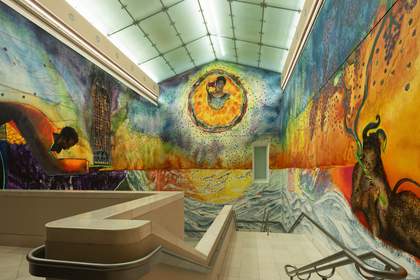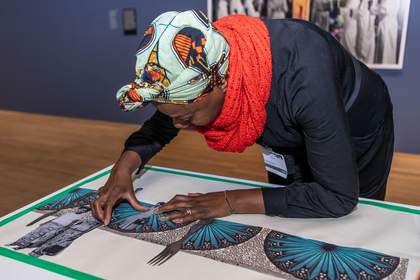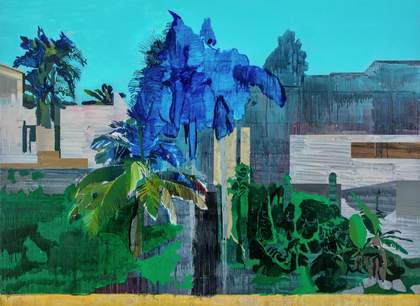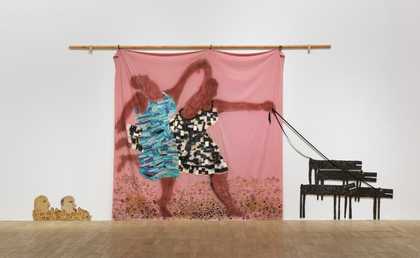We invited teacher Nakessa Simpson to explore Tate’s collection and select an artwork that could inspire creative activities and meaningful discussions about Black histories in the classroom.
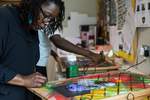
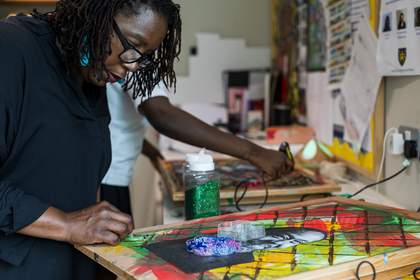
Teacher Spotlight: Chris Ofili
Explore Black histories and honour those who have come before us with teacher Nakessa Simpson
About Nakessa Simpson
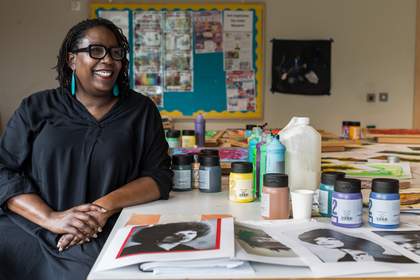
Photo © Hydar Dewachi
"I am an artist first and foremost and have a passion to teach art and design to marginalised groups. I believe art should be accessible to all regardless of race, religion, class or gender. I teach young people who have been excluded from mainstream school.
My approach is one of inspiring young people to find their own creative voice, having access to as many mediums, tools and materials as possible, making sure there are no limits."
About the artwork
-
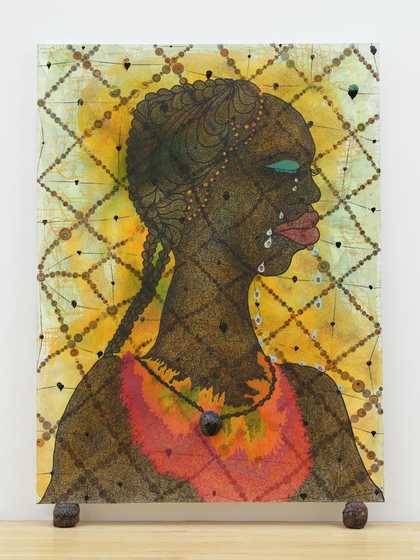
Artwork
No Woman, No Cry
Chris Ofili1998
Chris Ofili is a British artist who works across a variety of media, making highly detailed and vibrant collages that speak to the historical and contemporary Black experience. Ofili is known for building up layers of resin, glitter, magazine cut-outs, popular imagery and elephant dung alongside more conventional art materials.
"It's important that this generation knows the story of Stephen Lawrence and what his mother achieved in changing the law and holding corrupt police officers to account. The tragic story of Stephen Lawrence and the amazing achievements of Doreen Lawrence are part of our history. You can teach Black history through art."
Nakessa Simpson
Starting points
These prompts, devised by Nakessa, model the different ways she would approach supporting her students to explore the themes in No Woman, No Cry.
Content Guidance
This activity touches on subjects such as violence, racism, racist language and injustice by the police. When researching the case, some may find details upsetting. We suggest teachers assess the suitability of this resource for their students.
"It is okay to open this up, to have these conversations in the classroom. It’s actually very important."
Nakessa Simpson
- What do you know about the case of Stephen Lawrence? Why do you think the artist chose to focus on Lawrence’s mother, Doreen?
- Chris Ofili is known for using unconventional materials in his works. What materials can you see here? Do you notice any that you’ve not seen in an artwork before? Make a list of all the materials you can see in this work.
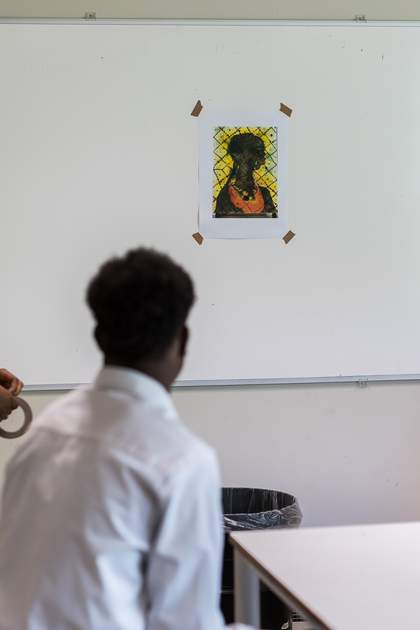
Photo © Hydar Dewachi
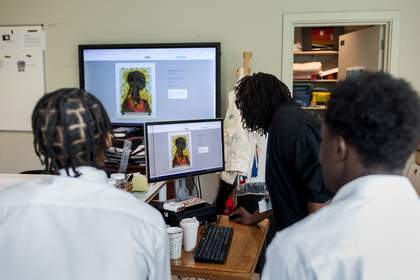
Photo © Hydar Dewachi
- What feelings does this work bring up for you? Is this the same as your classmates, or are there a range of feelings? Do you think the artist is trying to get you to feel a specific emotion?
- The caption tells us that there are layers of writing, like ‘RIP Stephen Lawrence 1974–1993’ hidden under the top layer of paint. Why would an artist hide or cover over certain things? Does reading that text change how you understand the work?
Make
In this set of activities devised by Nakessa, students are invited to learn about the history of Stephen and Doreen Lawrence, discuss Doreen Lawrence's impact, and create a collage inspired by someone who has created change.
"It is powerful that she [Doreen Lawrence] is still alive ... this is recent history."
Nakessa Simpson
You will need
- A3 –A2 Card
- Scrap cardboard
- Watercolours
- Beads, buttons, glitter and any other found objects
- Acrylic paint
- Acrylic pens
- PVA glue/medium or transparent gloss
- Photocopies
- Magazines
Research the case
Duration: 30 Minutes
- Research the case of Stephen Lawrence independently or in small groups. Independent learners could use the internet, books, newspapers, and create a PowerPoint. SEN/SEMH teachers could provide some facts and information that students could read through.
- Print off your PowerPoint or any important things you find.
- Take pauses as the information emerges and discuss, write down, or draw how you are feeling about the information you find.
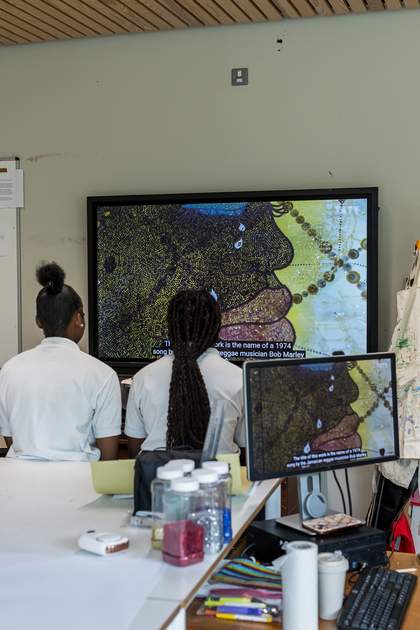
Photo © Hydar Dewachi
Display
Duration: 30 Minutes
- Arrange all your researched information from the Stephen Lawrence case on a wall. Arrange the information in a timeline by drawing arrows, as if solving a case.
- Add details from your own life to this timeline. Where do the stories overlap?
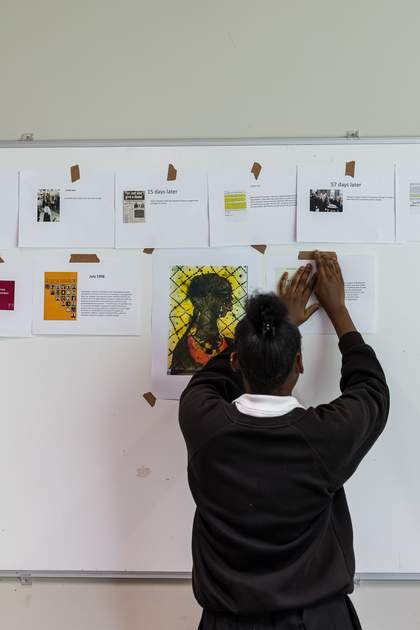
Photo © Hydar Dewachi
Discuss your findings
Duration: 20 Minutes
Use this collective research and learning to have conversations including the following points:
- What feelings come up for you after seeing your research mapped out? Talk about them, write them down, or draw them.
- How do you think Stephen Lawrence's parents felt when they heard of his death?
Did his parents expect justice? How would you feel and what would you expect to happen? - What have you learnt about what his mother has done through the years?
- What is your own relationship with the police?
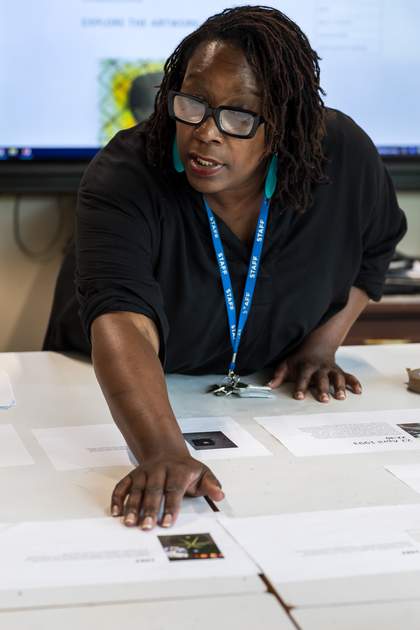
Photo © Hydar Dewachi
Adapt
Collect or create symbols that represent what your students might encounter when learning about the Stephen Lawrence case. You could use colours to represent different emotions, or collect objects that relate to dying or death, sadness, pain, justice, perseverance, etc. Some suggestions include:
Wilted flower (death), Picture of a dark cloud (sadness), Broken heart (sadness), Scales (justice), Boxing glove (anger), The colour red (anger)
Lay out the symbols representing different emotions on the table and ask your students to point to what they feel after learning about the Stephen Lawrence case and its impact on society.
"How can you process grief? It makes me think of Maya Angelou and how her work invites us to transform pain and struggles into something powerful and healing. This is the power of art – it allows you to feel."
Nakessa Simpson
Make a background for your figure
Duration: 20 Minutes
Chris Ofili chose to honour Doreen Lawrence because he ‘was deeply moved by the way in which [her] overwhelming silent grief at her son’s tragic death had been transformed [and] she became even stronger in spirit and emboldened to speak with great dignity’. Her work has led to police reform and has broadened society’s understanding of structural and institutional racism.
- Reflect on and choose someone close to you or from the past, who created change for us and who you would like to honour.
- Start by creating a background of colours using watercolours and cardboard edge or use a roller to spread swoops of colour across your surface. Make sure there are no white spaces left. Use as many or as few colours as you like.
- Let these surfaces fully dry
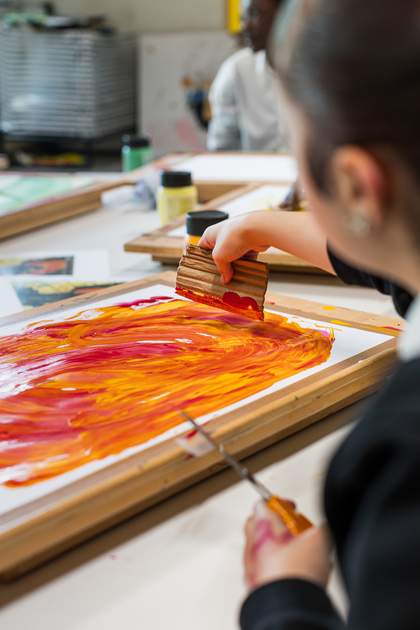
Photo © Hydar Dewachi
Make your portrait
Duration: 30 Minutes
- Start to make a grid or any type of pattern on top of your dried colourful background using paint or acrylic paint pens
- Draw, paint, or collage your portrait on top of the pattern you’ve made
- Think back to the materials Ofili used – what everyday materials have you never seen in an artwork? Incorporate unexpected objects such as beads, buttons, pieces of fabric, cut-out shapes from paper into your collage.
- Consider materials that feel celebratory like glitter, sequins, metallic paper or paint to further decorate your portrait image.
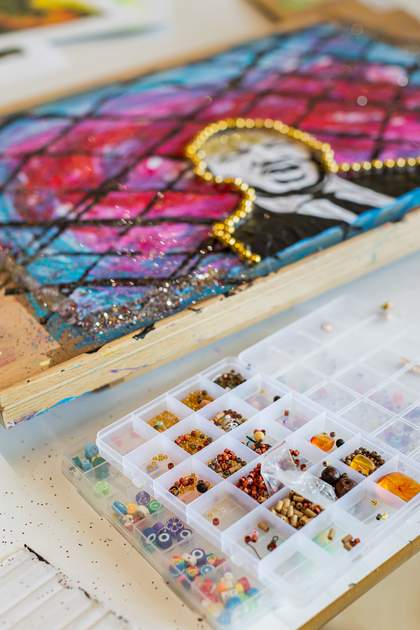
Photo © Hydar Dewachi
"Art can open up so much about your own history."
Nakessa Simpson
Extend
Duration: 30 Minutes
Explore race and justice using found objects:
- Collect a series of small objects that you feel relate to the person you would like to honour, that relate to your personal history or to your own experiences of identity, justice and injustice.
- Make a 3D sculpture of a head using your found objects and a hot glue gun. Add layers of objects onto the surface, make it as colourful as possible. What does adding more and more objects do? What stories does the head begin to tell?

Photo © Hydar Dewachi
Make it Sensory
Additional Options for Sensory Learners
Ask your students for photos of friends or family that they would like to honour or photos of anyone they admire. Print them out in A3 size and use them as your starting point.
Your student could use their hands or fingers to paint over the photos with watercolour paint, or you could use hand over hand support pulling colours across the page over the photo with cardboard, as in the main activity. Hand over hand support could also be used to stick beads and buttons other materials to the image.
Take time to explore the additional materials first. Fill a tray with buttons or beads or sequins first and encourage them to look in, explore, and feel.
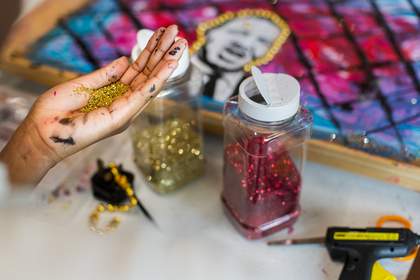
Photo © Hydar Dewachi
Nakessa's Picks
Nakessa has selected additional works from the Tate collection that relate to Black histories and identities. Use them as inspiration or bring them into your classroom.
"This work, honouring Khadija Saye, is not only about black histories – it is about class and about being poor and having lived in a vulnerable space. And it’s an honouring from one black artist to another."
Nakessa Simpson
-
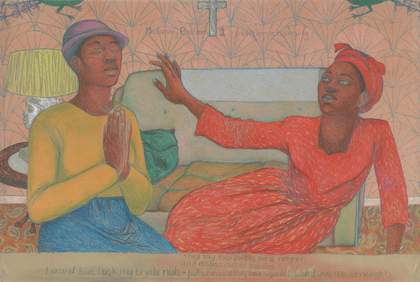
Missionary Position II
Sonia Boyce OBE1985 -
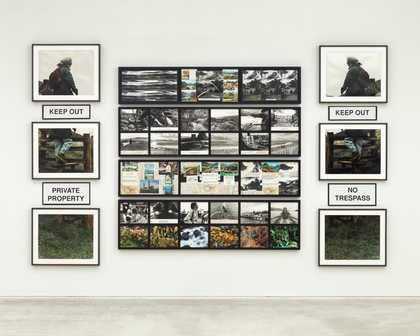
The Cost of the English Landscape
Ingrid Pollard MBE1989
"These stories that are more recent, about us, and are important, and we don’t know much about them."
Nakessa Simpson
How to use Teacher Spotlights
This resource offers a modular flexible approach: use the prompts and activities as a full sequence of lessons, choose a single idea to adapt for your classroom.
Teacher Spotlight resources are designed to increase your confidence in using Tate’s evolving collection to engage with big conversations in your classroom. Each resource is co-created with an expert teacher and shares real world examples of how they have successfully used the artworks in their teaching.
You are invited to draw inspiration and nourish your practice by seeing how other teachers approach working with artists and artworks in the classroom.

